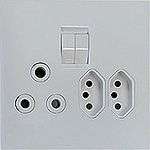IEC 60906-1

IEC 60906-1 is an international standard for 230 V AC domestic power plugs and sockets. It was conceived as a common mains plug and socket standard for use in territories with 230 V mains.[1] The standard was originally published by the International Electrotechnical Commission in 1986, the current edition is ed2.0 published in 2009. Although it looks similar to the Swiss SEV 1011 plug, its dimensions are different. As of July 2014, only South Africa has introduced a standard (SANS 164-2)[2] based closely on IEC-60906-1. Brazil used it as the basis for its NBR 14136 standard, but this is not compatible with IEC-60906-1.
This article is only about part one of IEC 60906. Part two, IEC 60906-2, defines a global standard plug for 100–130 V mains compatible with the NEMA 5-15 plug and receptacle used today in North America and Japan. Part three, IEC 60906-3, defines a family of extra low voltage connectors.
Features
IEC 60906-1 plugs and socket-outlets are rated 16 A, 250 V AC and are intended for use on distribution systems having nominal voltages between 200 V and 250 V AC. IEC 60906-1 defines both 3-pin connectors for Class I appliances and 2-pin versions for Class II appliances. (Additional oval-shaped 2-pin connectors for Class 0 appliances defined in the first edition of the standard were never implemented and no longer appear in the current second edition.)
The IEC 60906-1 plugs are smaller than any other European plug with 16 A rating. The sockets are small enough that two can be installed in the space taken by a single Schuko or BS 1363 socket. The plugs are slightly larger than the Europlug and provide much more reliable contact.
The socket has either a 10 mm deep recess or a 12 mm high rim, to exclude incompatible plugs. It ensures that the protective-earth pin establishes contact before the line and neutral pins. Sockets are required to have shutters for the line and neutral apertures.
For most existing European systems (Schuko, etc.), it would be possible to design sockets that can accept both the traditional plug as well as the IEC 60906-1 Class I and II plugs, thereby enabling a smooth transition to the new system. However, the IEC 60906-1 standard explicitly discourages the use of multi-standard sockets, claiming that such sockets are likely to create safety problems when used with plugs from other countries.
Dimensions
IEC 60906-1 plugs are similar in size and shape to the Europlug, with the front profile being a flat hexagon. They are nominally 35.5 mm wide. The 3-pin Class I plug is 17 mm high, whereas the 2-pin Class II plug is 14 mm high (similar to the Europlug). The parallel side faces are 26 mm apart, and the two pairs of side faces are orthogonal to each other. The line and neutral pin are on centres spaced at 19 mm (as on the Schuko and Europlug). The pins are 19 mm in length with a diameter of 4.5 mm (Schuko is 4.8 mm, Europlug is 4 mm). In common with the Europlug there is an insulating sleeve around the base of the line and neutral pins. The 3-pin version has a round protective-earth pin of the same length and diameter as the line and neutral pins, but no insulating sleeve. The protective-earth pin's center is offset 3 mm from the center point between the line and neutral pin.
South African SANS 164-2 standard


South Africa is the only country to have incorporated IEC 60906-1 plugs and sockets into its own national standards as SANS 164-2. SANS 164-2 was made the preferred standard in 2013, but according to the South African Bureau of Standards (SABS) electrotechnical standards development manager, the new plugs and sockets would have "a long, long phase-in period, more than 20 years".[3]
Brazilian NBR 14136 standard

Brazil uses both 127 V and 220 V mains supplies, but rather than using the IEC 60906-2 standard for the lower voltage it uses NBR 14136 for both. Whereas IEC 60906-1 specifies a single 16 A rating with 4.5 mm pins, NBR 14136 has both 10 A and 20 A ratings, the 10 A plug has a pin diameter of 4 mm, and the 20 A plug is 4.8 mm. The 10 A socket will accept only 10 A plugs, and Europlugs, while the 20 A socket will accept both 10 A and 20 A plugs, plus Europlugs.
Comparison with traditional systems
Thanks to modern injection moulding technology, robust and safe plugs can be smaller today than was considered feasible when the old Schuko and BS 1363 systems were designed in the early and mid 20th century.
BS 1363
The IEC 60906-1 system features many of the advantages of the BS 1363 plug. It is smaller than a BS 1363 plug, and is rated for 16 amperes instead of 13. The flat design avoids the risk of stepping on upward-facing pins. However, IEC 60906 does not mandate a fuse in each plug for protection of the flexible cord.
Schuko
The IEC 60906-1 system also avoids the problems of the Schuko and French systems currently used in most of Europe and large parts of Asia:
- Ambiguity between line and neutral on Schuko.
- Large size.
- Mateability of Class I plugs with commonly used two pin sockets that lack protective-earth contacts.
Swiss plug
The IEC 60906-1 plug looks similar to the Swiss SEV 1011 plug, but the latter has smaller diameter pins (4.0 mm), the ground pin is offset more (5 mm), and it is only rated for 10 A.
See also
References
- ↑ IEC 60906-1 standard household plug, Digital Museum of Plugs and Sockets
- ↑ Botha, Mark (2014-02-14). "New plug and socket system for SA". Vector. Retrieved 2015-04-20.
- ↑ , BDLive
- IEC 60906-1 IEC system of plugs and socket-outlets for household and similar purposes - Part 1: Plugs and socket-outlets 16 A 250 V a.c.
- Brazilian Standard NBR 14136, July 2001.
- South African Standard SANS 164-2:2006.